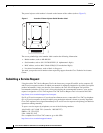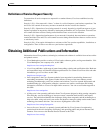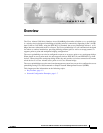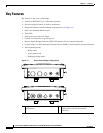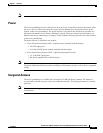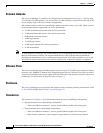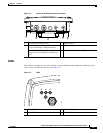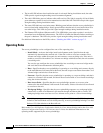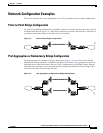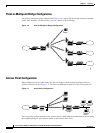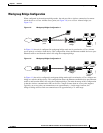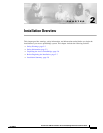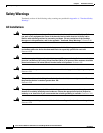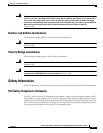
1-6
Cisco Aironet 1300 Series Outdoor Access Point/Bridge Hardware Installation Guide
OL-5048-02
Chapter 1 Overview
Key Features
• The install LED indicates that installation mode is activated. During installation mode, the other
LEDs provide signal strength readings used for antenna alignment.
• The radio LED blinks green to indicate radio traffic activity. The light is normally off, but it blinks
green whenever a packet is received or transmitted over the radio link. This LED also provides signal
strength readings during installation mode.
• The status LED indicates association status. Blinking green indicates that the access point/bridge is
not associated with another bridge. Steady green indicates that the unit is associated with at least
one other bridge. This LED also provides signal strength readings during installation mode.
• The Ethernet LED indicates Ethernet traffic. This LED blinks green when a packet is received or
transmitted over the Ethernet infrastructure. The LED is off when the Ethernet link not working or
the port is shutdown. This LED also provides signal strength readings during installation mode.
For additional information on the LEDs, refer to “Checking the LEDs” section on page 7-2.
Operating Roles
The access point/bridge can be configured into one of five operating roles:
–
Install Mode—Activates the bridge install and alignment mode. Specifies that the unit
automatically determines the network role. If the unit is able to associate to another Cisco
Aironet root bridge within 60 seconds, the unit assumes a non-root bridge role. If the unit is
unable to associate with another Cisco Aironet root bridge within 60 seconds, the unit assumes
a root bridge role.
You can also pre-configure the access point/bridge into root bridge or non-root bridge modes
and avoid the 60-second automatic detection phase.
–
Root—Specifies that the access point/bridge is operating as a root bridge and connects directly
to the main Ethernet LAN network. In this mode, the unit accepts associations from other Cisco
Aironet bridges and wireless client devices.
–
Non-root—Specifies that the access point/bridge is operating as a non-root bridge, and that it
connects to a remote LAN network, and that it must associate with a Cisco Aironet root bridge
using the wireless interface.
–
Root Access Point—Specifies that the access point/bridge operates as an access point
connected to the main Ethernet LAN network. In this mode, wireless client devices are allowed
to associate to the unit.
–
Workgroup Bridge—Specifies that the access point/bridge operates as a workgroup bridge
connected to a small wired Ethernet LAN network through an Ethernet hub or switch. The
workgroup bridge must associate to a Cisco Aironet access point or a Cisco Aironet bridge.
Note On initial power up, an access point/bridge running Cisco IOS Release 12.3(2)JA2 and earlier
defaults to the Install-Mode role. On initial power up, an access point/bridge running Cisco IOS
Release 12.3(4)JA defaults to the Root AP role.
Refer to the Cisco IOS Software Configuration Guide for Cisco Aironet Bridges and to the Cisco IOS
Software Configuration Guide for Cisco Aironet Access Points for additional information on the
operating modes supported by the access point/bridge.



